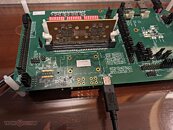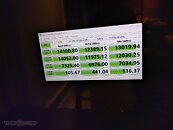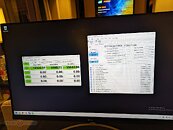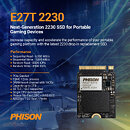- Joined
- Oct 9, 2007
- Messages
- 47,511 (7.49/day)
- Location
- Hyderabad, India
| System Name | RBMK-1000 |
|---|---|
| Processor | AMD Ryzen 7 5700G |
| Motherboard | ASUS ROG Strix B450-E Gaming |
| Cooling | DeepCool Gammax L240 V2 |
| Memory | 2x 8GB G.Skill Sniper X |
| Video Card(s) | Palit GeForce RTX 2080 SUPER GameRock |
| Storage | Western Digital Black NVMe 512GB |
| Display(s) | BenQ 1440p 60 Hz 27-inch |
| Case | Corsair Carbide 100R |
| Audio Device(s) | ASUS SupremeFX S1220A |
| Power Supply | Cooler Master MWE Gold 650W |
| Mouse | ASUS ROG Strix Impact |
| Keyboard | Gamdias Hermes E2 |
| Software | Windows 11 Pro |
The current crop of PCIe Gen 5 based M.2 NVMe SSDs run scorching hot to deliver sequential transfer speeds of 10 GB/s, requiring some massive cooling solutions with tiny fans. All this might change, as Phison, a leading SSD controller manufacturer, unveiled three new controllers at the 2024 International CES. One of these that stands out, is the PS5031-E31T, which is built on the 7 nm node, and could power the first Gen 5 SSDs delivering 10 GB/s without elaborate cooling solutions. This is a big upgrade from the 12 nm node used by their first Gen 5 controllers. The PS5031-E31T is a DRAMless controller meant for mainstream Gen 5 SSDs. This controller has a 4-channel flash interface (16 CE), a PCI-Express 5.0 x4 host interface, supports capacities of up to 8 TB, and is claimed by Phison to offer sequential transfer rates of up to 10.8 GB/s, and up to 1500K IOPS random access; exceeding the fastest Gen 4 SSDs.
Phison also updated its high-end controller lineup with the new PS5026-E26 Max14um. This is a variant of the E26 that's designed for the upcoming Micron B58R NAND flash chip that offers 2400 MT/s per channel transfers. Over the 8-channel interface of the E26, this finally unlocks sequential transfer speeds exceeding 14 GB/s reads, and 12.7 GB/s sequential writes. This is merely a revision of the existing E26 with updated power-optimized firmware, the underlying silicon is identical. The E26 Max14um is the first controller to surpass 1000 MB/s in all three PCMark 10 storage tests. We have a sample of an SSD powered by the E26 Max14um in our labs, and will post our review soon.





Next up, we have the PS5027-E27T. The E27T is a highly power-optimized 4-channel DRAMless controller with a PCI-Express 4.0 x4 interface, purpose built for small M.2-2230 SSDs powering handheld gaming consoles. Lastly, there's the PS2251-21 (U21). This is a brand new single-chip solution designed for the 40 Gbps USB4 interface, wiring out 4-channel NAND flash, with sequential transfers on offer that nearly max out the interface, measured at up to 4 GB/s. This controller allows portable SSD designers to do away with USB4 bridge chips that convert a USB4 uplink to a PCIe Gen 3 x4 downlink—no more clunky M.2 drives under the hood. Now you just have one of these chips directly wired to the NAND flash.
The CES 2024 presentation slide-deck from Phison follows.





View at TechPowerUp Main Site
Phison also updated its high-end controller lineup with the new PS5026-E26 Max14um. This is a variant of the E26 that's designed for the upcoming Micron B58R NAND flash chip that offers 2400 MT/s per channel transfers. Over the 8-channel interface of the E26, this finally unlocks sequential transfer speeds exceeding 14 GB/s reads, and 12.7 GB/s sequential writes. This is merely a revision of the existing E26 with updated power-optimized firmware, the underlying silicon is identical. The E26 Max14um is the first controller to surpass 1000 MB/s in all three PCMark 10 storage tests. We have a sample of an SSD powered by the E26 Max14um in our labs, and will post our review soon.





Next up, we have the PS5027-E27T. The E27T is a highly power-optimized 4-channel DRAMless controller with a PCI-Express 4.0 x4 interface, purpose built for small M.2-2230 SSDs powering handheld gaming consoles. Lastly, there's the PS2251-21 (U21). This is a brand new single-chip solution designed for the 40 Gbps USB4 interface, wiring out 4-channel NAND flash, with sequential transfers on offer that nearly max out the interface, measured at up to 4 GB/s. This controller allows portable SSD designers to do away with USB4 bridge chips that convert a USB4 uplink to a PCIe Gen 3 x4 downlink—no more clunky M.2 drives under the hood. Now you just have one of these chips directly wired to the NAND flash.
The CES 2024 presentation slide-deck from Phison follows.





View at TechPowerUp Main Site





